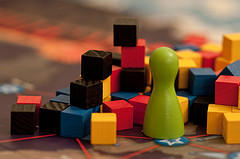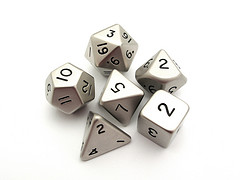Gaming 101 is a series of articles designed for new gamers. It will cover all the basics of gaming – from choosing a beginner’s game to hosting your first game night. Have something you want to see in Gaming 101? Email us or leave a note in the forums.
Traditional vs. “Designer” Games:
What Are We Talking About?
You may have noticed that we don’t talk about Monopoly or Clue very often around here. It’s not that these are necessarily bad games (though some of them are pretty awful), but we’ve all played them to death.
And, to be honest, they’re not very interesting.
The games we play here are sometimes called “Designer Games” or “Euro Games,” though both these titles are a little pretentious for a hobby that involves rolling dice and moving colorful blocks of wood around a cardboard square. Which, you know, is basically what we’re doing…
Anyway!
There are only two big differences between the games that you have stashed away in your closet with the games that we nerds have in ours: variety and luck.
Variety
Designer games come in all shapes, sizes, and types. Even if they’re not your thing, I guarantee that there are one or two of them that would totally float your boat.
 There are games for every occasion and every interest, from wine to trains to haunted houses. If you like it, there’s probably a game about it . . . it might not necessarily be a great game, but it’ll be there. From card games to board games to tabletop games, there’s a type of game for any type of player.
There are games for every occasion and every interest, from wine to trains to haunted houses. If you like it, there’s probably a game about it . . . it might not necessarily be a great game, but it’ll be there. From card games to board games to tabletop games, there’s a type of game for any type of player.
Do you like to sit down and plan things out? Or are you more of a free spirit? Would you like to get really into the background of the game? Maybe you just want to play with friends every now and then. Do you want a game of complexity and depth or would you rather one that can be played in short time periods? Are you looking for a family-friendly session or a raunchy party game? Designer games have them all.
Luck.
A lot of traditional games, like Chutes & Ladders and Candyland, rely primarily on luck. You roll the dice or draw the card and it tells you what to do.
 This can be fun because you never know what’s going to happen. But it can also get boring, because you don’t have to make any decisions about how you’re playing the game. You don’t have to think about it, so you never become invested in the outcome. Sure, you still want to win, but ultimately you’re just along for the ride.
This can be fun because you never know what’s going to happen. But it can also get boring, because you don’t have to make any decisions about how you’re playing the game. You don’t have to think about it, so you never become invested in the outcome. Sure, you still want to win, but ultimately you’re just along for the ride.
Most designer games also involve luck, but to a much lesser degree. In these games, you also have to make decisions about what you’ll do on your turn. Whether you move left or right has an impact on the options available to you in the future and on the points you’ll score. The games are less linear (i.e. you have many options – not just move forward or move back), so larger doses of strategy are involved.
In these games, luck is second to strategy. Luck is introduced to add variety and difficulty to the game. That is, it is added to throw a little wrench into your perfectly laid plans. This keeps you on your toes and, consequently, keeps you more engaged and interested. They also keep the game from becoming repetitive and stale, meaning you’re much more likely to play it again later. Ask yourself this: when was the last time you played Risk?
So, variety and luck. Those are the differences between the games we tend to talk about here at The Cardboard Republic and the games you remember from your childhood. Ultimately, they’re more similar than they are different, and if you remember enjoying Clue or Monopoly or any of the others, you’ll likely enjoy non-traditional board games as well. The best part is that you can play them with just about anyone – friends, family, kids. You can even play some of them by yourself if you want to.
If you think you would like to try a “designer game,” read our next article for some good suggestions, or ask around our forums.
Photo Credits: Pandemic cubes by Robert Paul Young; dice by Andreas Hopf
